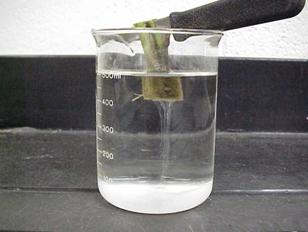Bacterial Wilt of Tomato
Pathogen: Bacterial wilt of tomato, caused by the bacterium Ralstonia (Pseudomonas) Solanacearum.
Host: This disease is quite common in South Carolina, especially in moist, sandy soils of the midlands and coastal plain. This bacterium has a wide host range of 200 plant species in 33 plant families. Other members of the family Solanaceae, such as potato, eggplant and tobacco are among the susceptible plants. There are no effective chemical controls.
Symptom: Mature, fruit-bearing plants are affected in mid-summer. The first symptom is wilting of a few leaves. This often goes un-noticed. Soon thereafter, the entire plant wilts suddenly and dies. Such dramatic symptoms occur when the weather is hot (86-95 F), and soil moisture is plentiful. Under less conducive conditions, wilt and decline will be slower, and numerous adventitious roots often form on the lower stems. In both cases, a brownish discoloration is present, first in the vascular system, and in advanced cases, spreading into the pith and cortex. The roots will exhibit varying degrees of decay.
Pathogen cycle: The pathogen enters the roots through wounds made at planting, through cultivation or by nematodes or insects. Natural wounds made by root emergence are also points of entry. The bacteria multiply in the vascular system, eventually clogging the water conducting vessels with bacterial cells and slime.
Management: After plants die, the bacterium is released into the soil from decaying roots and stems, so remove infected plants immediately. It is spread by running water and infested soil to adjacent areas. Infected transplants can introduce the pathogen into uninfested soil. The bacterium survives for long periods in the soil, even in the absence of host plants. Rotate away from tomatoes, peppers, eggplant, Irish potatoes, sunflowers, and cosmos for at least 3 years. Use raised beds to improve soil drainage. The varieties 'Neptune' and 'Tropic Boy' are partially resistant. To minimize spread to other parts of the garden, till infested areas last and wash tines thoroughly after tilling. An alternative way to avoid the disease is to plant tomatoes in commercial potting soil in containers.
Diagnosis: (see photo 1 below) An easy way to diagnose this disease is to cut the stem at the base of the plant and check for discolored vascular tissues and pith. If present, rinse the stem and suspend it in a glass of water. If infected, a whitish substance consisting of bacterial cells and slime will flow from the xylem into the water within 3 to 5 minutes.

1. Diagnosis of Tomato Bacterial Wilt
